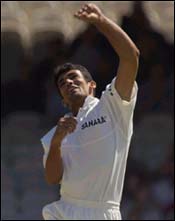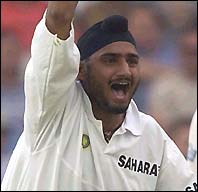Bowling partnerships and team purpose
Daniel Laidlaw
The series has reached its half-way point and for India it is definitely a
case of glass half-empty rather than half-full.
Sourav Ganguly said after the first Test that all touring sides struggle in the first Test and that
there is lots of cricket left. Any period of grace, not that it really
existed, is now well and truly over. With consecutive wins at Headingley and
the Oval required for an unlikely victory, it is time for India to show the
fortitude and desire necessary to reverse their series fortunes. And in
their weakest department, a virtual 180-degree reversal is indeed needed.
Batting, captaincy, fielding, 'keeping... none of it can really help win
without motivated, quality bowling. If the first Test, when England made 487
aided in part by India's indiscipline, was bad, then the second, on a more
helpful pitch, was appreciably worse. Inept and seemingly indifferent, it
took nearly a day's worth of lost play and 115 overs of solid rearguard
batting to save a match in which India had posted a respectable first
innings 357.
 The failure of the bowling attack is at first impression due mostly to
quality. At this stage of their careers Zaheer, Nehra and Agarkar are to
varying degrees probably over-rated as Test bowlers. Realistically, they don't form an imposing unit. However, there is also an important question of approach, desire, and just how much value India places on Test cricket, the answers to which could make a difference to the overall bowling picture.
The failure of the bowling attack is at first impression due mostly to
quality. At this stage of their careers Zaheer, Nehra and Agarkar are to
varying degrees probably over-rated as Test bowlers. Realistically, they don't form an imposing unit. However, there is also an important question of approach, desire, and just how much value India places on Test cricket, the answers to which could make a difference to the overall bowling picture.
There exists is a perception, sometimes abetted by the focus of supporters,
that India is a somewhat individualistic batting-obsessed team overly
concerned with records and "performances" instead of winning as many Tests
as it should. It can also appear India has been distracted by the prospect
and occasional moments of one-day glory, on which too much emphasis is
placed, while too readily accepting repeated Test failure abroad.
Reader Sriram Sivasankaran made some thoughtful observations along these
lines recently. "The real point is the difference placing emphasis on Test
cricket versus one-day cricket.
"This fundamental flaw in not understanding the importance of Test cricket
is one of the key reasons why India has remained a mediocre Test nation
especially since 1983. For Australia, winning the 1987 World Cup was the
launch pad for success in becoming a world champion side in both forms of
the game. Winning the World Cup in 1983 was one of the worst things that
could have happened to Indian cricket as the World Cup has become an
obsession and an end in itself."
Whatever the lasting effect of World Cup success 20 years ago, India does
not manifestly appear to embody all the qualities of the best Test teams of
the present day. Listing the attributes which in part separate Australia and
South Africa as the top two teams, one thinks of a fierce determination,
genuine desire to work hard to improve, and above all commitment to the
sense of team purpose - though the last does not come to mind instantly
because it is accepted as a given. They possess talent, ability and "stars,"
but it's not significant. Or at least, those types of external
characterisations are secondary, because they mean nothing in terms of
performance.
Australia and South Africa appear to have a clearly understood, though
tacit, set of priorities to which all else is subordinate. A team ethos and
justified belief that if all strive to give the best of themselves, to work
for their team-mates, then success will surely follow. A professional level
of analysis, planning and goals adds to the preparation and sense of
purpose, but the effort is typically towards the next circumstance that can
be controlled - hence Ricky Ponting recently saying talk of the World Cup
will be consciously avoided, as it will take care of itself when it comes
around.
I admit to being biased in favour of the qualities described above, simply
through having followed the rise and rise of Australia from the early-to-mid
nineties onwards. What Australia has achieved during that span is marvellous
and the mentality which has driven it to success generally to be admired.
However, this is not to claim that in a sport as richly diverse as cricket
this mentality should be slavishly copied merely because it works for them.
But it does make a useful starting point, as in any sport the strengths of
the best tend to be adopted until someone else devises another method to
improve, which is then incorporated by the rest all over again. There should
be room for taking some of the universal sporting principles currently best
exemplified by Australia and South Africa and using them in the most
appropriate context for India.
For whatever reason, India's bowlers have not performed in a manner
appropriate to team needs. Fundamental, obvious, but still too often
overlooked is the creation of pressure on the batsmen, something not
achieved by each bowler just following his own whims.
The essential value of establishing partnerships is often discussed in
relation to batting; less so when it comes to bowling. "Partnership" in a
bowling team's context is perhaps even a misnomer, as at its best it's more
like a network in which 11 players see themselves as significant
contributors in the business of dismissing the batsmen. It's too easy to see
cricket as a game of one-on-one, the gladiatorial clash between the single
bowler and lone batsman. Frequently more telling is the combined and
sustained pressure brought to bear by the whole.
 Simply, the better teams realise their bowlers are involved in partnerships
with the team-mate operating from the opposite end. India's, if they have
been fully appreciative of this during the first two Tests, haven't bowled
like it. Harbhajan Singh is presently India's best bowler, but as well as
using him effectively, it is incumbent upon the rest of the attack to
recognise the threat he should present and to provide the necessary support.
Even with ideal field settings and Harbhajan bowling a perfect line, his
potency is considerably diminished if there are easy runs available at the
other end. Were he to receive support from a partner prepared just to be
disciplined without bowling for wickets, then the pressure becomes
intensified and wickets often result anyway.
Simply, the better teams realise their bowlers are involved in partnerships
with the team-mate operating from the opposite end. India's, if they have
been fully appreciative of this during the first two Tests, haven't bowled
like it. Harbhajan Singh is presently India's best bowler, but as well as
using him effectively, it is incumbent upon the rest of the attack to
recognise the threat he should present and to provide the necessary support.
Even with ideal field settings and Harbhajan bowling a perfect line, his
potency is considerably diminished if there are easy runs available at the
other end. Were he to receive support from a partner prepared just to be
disciplined without bowling for wickets, then the pressure becomes
intensified and wickets often result anyway.
This is proven not only in the way a champion pairing like Warne-McGrath
perform, but even White-Flintoff or Vaughan-Hoggard. The principles are the
same irrespective of quality. Committing to them, though, requires a sense
of team purpose and an element of self-sacrifice. The best sides purport to
enjoy each other's success as much as their own and it's necessary for India's bowlers to see wickets achieved by team-mates as a result of pressure exerted by both as a triumph.
It is easy to be short-sighted and consider only the consequences of one's
own spell. In the awful manner in which Agarkar bowled during the second
Test, for example, it was difficult to conceive there was any depth of
thought given to creating pressure for his partners. Too full, too short,
too wide and generally hapless, Agarkar's bowling was symptomatic of the
slightly less aimless way in which India bowled generally.
Ability is a factor, but a well-organised India with its priorities in order
should relish the prospect of bowling to England regardless, in the way in
which a depleted England have taken up the challenge of bowling to India,
despite the batsmen winning some of those clashes. The approach can't be
faulted, which is not currently true of India.
Batting, perhaps, allows more scope for individual strategy and
self-expression, indeed self-centredness, though this too can go awry as it
did with Tendulkar and Dravid during the first Test. In becoming a better
bowling side, a greater understanding of team requirements is needed, which
India currently either does not appreciate or is unable to implement. To be
sure, poor batting has been responsible for many of India's away defeats.
But in the longer term, a change of priorities is necessary, particularly in
how the members of the bowling attack perceive their roles.
More Columns
Mail Daniel Laidlaw